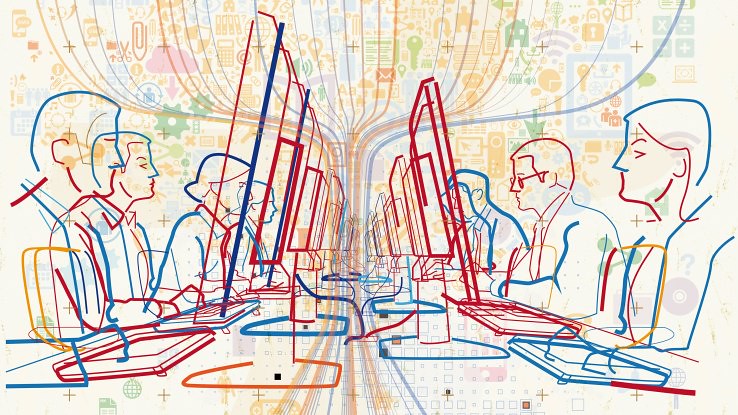Communication is one of the key ways that we as humans distinguish ourselves from the rest of the living world. Languages are essentially the foundation stones for all the different cultures of the planet, in addition to being the chosen way we exchange our values and beliefs with each other. That’s probably why DevOps begins with good communication and for a DevOps revolution to take hold in your organization, improving the way people communicate with each other is the place to start. This is because DevOps culture is about maintaining smooth, transparent, and timely communications between teams that have historically been at loggerheads with each other. When we talk about high-performing DevOps teams today, it’s important to remember that qualities like agility or the ability to respond quickly and efficiently to any kind of incidents or setbacks all stem from good inter and intra-team communication.
DevOps collaboration

Collaboration today is all about people or teams focusing all their energy in one common direction through interaction and input. While DevOps no doubt started by just getting the different teams in an organization to talk to each other and keep each other in the proverbial loop, it’s now about much more than that and collaboration is ideally end-to-end. This means all teams are involved at every stage of a project right from development to deployment and responsibilities are shared equally. When we look at the good collaboration between modern-day DevOps teams, it isn’t just about exchanging information back and forth, but also about creating an environment of continuous real-time feedback and response for everyone involved. This not only creates a culture where feedback is appreciated and acted upon instantly but also lends stability to an environment where application changes are fast and frequent.
Collaboration tools

While no tools or technologies have yet been able to substitute for basic human empathy and good communication skills, there are quite a few that enable and help good team collaboration. These tools not only allow team members to communicate effectively and efficiently but also allow them to share work, update each other on schedules and deadlines and track progress related to ongoing tasks. Modern collaboration tools can even be used to collaborate between teams that are in different geographical locations, nullifying distance and enhancing the virtual experience. Think of these collaboration tools as the remedy for the communication silos of the past. While the latter prevented teams from building off of each other’s ideas and accomplishments, the former is going out of its way to enable and enhance just that. In addition to reducing operational delays and communication gaps that commonly occur between teams that are geographically distributed, these tools also allow teams to remotely manage workflows and run diagnostics.
Slack
Slack refers to a set of popular team collaboration tools and online services developed by Slack Technologies and though it’s often referred to as a messaging tool, it does a lot more than that. Slack gives its users one single platform to connect with each other in several ways, effectively replacing emails, texts and instant messaging. In addition to running on work computers, Slack is fully native for both iOS and Android devices, giving you the best possible user experience, regardless of device. Useful “DevOps” features are the ability to get someone’s attention by mentioning them, after which a push notification gets sent to their phone. That and the ability to start video or voice conference calls at any time make Slack especially good for real-time collaboration. You can also bolster and boost Slack’s abilities by integration with other tools, like those that monitor and alert, for example.
Confluence

Confluence comes from the makers of popular project management and bug tracking tool Jira and allows users to create projects that other users from the team can then edit and leave comments on. Atlassian has been on quite a spending spree in the collaboration market, picking up Trello, OpsGenie, and Agilecraft in the last three years alone, not to mention they already own Bitbucket and a small stake in rival Slack. Atlassian also purchased Good Software earlier this year in April and with the acquisition launched a new version of Confluence with 15 new features including extended analytics. It also lets you access your JIRA content in Confluence, making it quite handy and convenient for JIRA users. Other new features include an updated editor tools to create tables of content, roadmaps, actionable items as well as new templates and an updated UI. Also included are “smart-links” that automatically preview content for services like Google Drive, Dropbox, and GitHub.
Microsoft Teams
While Microsoft’s take on collaboration may have been late to enter the market, some surveys suggest it has already overtaken market leader Slack with even faster growth expected in the years to come. This is no doubt due to all the Office 365 customers that effectively “inherit” Microsoft Teams as their go-to chat/collaboration software. Teams is a messaging tool at heart and one that not only enables text between users but one that supports group chat with conversation threads that can be followed systematically. In addition to supporting over 18 languages, all communications are real-time and users can switch to video conferencing with a push of a button. Microsoft also has native apps for almost every device including web, Windows, iPhone, Android, and Mac. In addition to group chats and private messaging, Teams also lets you create “workspaces” that are highly customizable and can be integrated with hundreds of different tools and features from the Microsoft universe.
Discord
Discord is quite an interesting entry to our list, especially since it was originally designed as a “digital distribution platform” for gamers to collaborate and communicate with each other on. While it differs from Slack in the sense that it’s targeted at gamers, this doesn’t stop DevOps teams from taking advantage of its features and abilities, especially since they’re free. This is kind of similar to when the enterprise realized GPUs can do a lot more than run video games and started using them for applications in AI and machine learning. It’s important to remember that gamers have pretty high standards and there’s always a lot of competition, so if Discord is the gamer’s choice for high quality, lag-free voice chat, it must be pretty good. Also, you can customize the color scheme to a dark mode for people who like to work (or play) at night. (Slack has also recently added dark-mode capability.)
DevOps communication: Creating a collective consciousness
Once you move on from the silos of the past and into the virtual collaboration workspaces of the preset, there’s no looking back. Having not just the ability, but also the tools at hand to collaborate, communicate and share information with team members across the planet, is something powerful indeed. While the pyramids of Egypt and the Great Wall of China are a testament to what humans can do when they work together and in unison, DevOps collaboration is taking it to the next level. The new level of communication is about creating almost a collective consciousness for the team where going further is just going to be about oiling an already well-running DevOps machine that thinks, eats, and breathes as one.
Featured image: Pixabay



